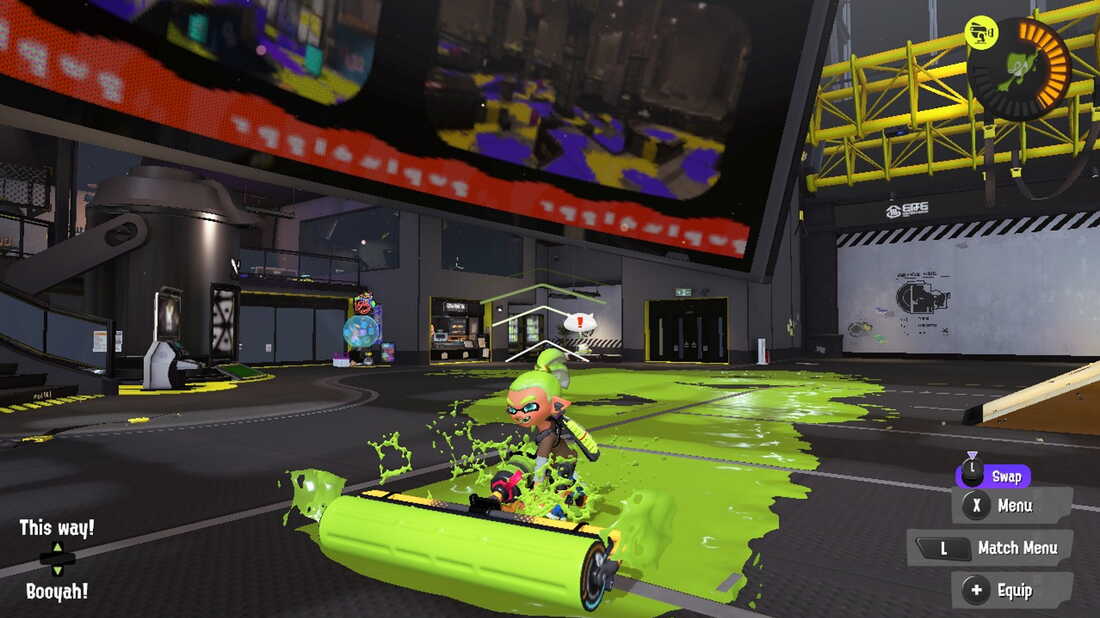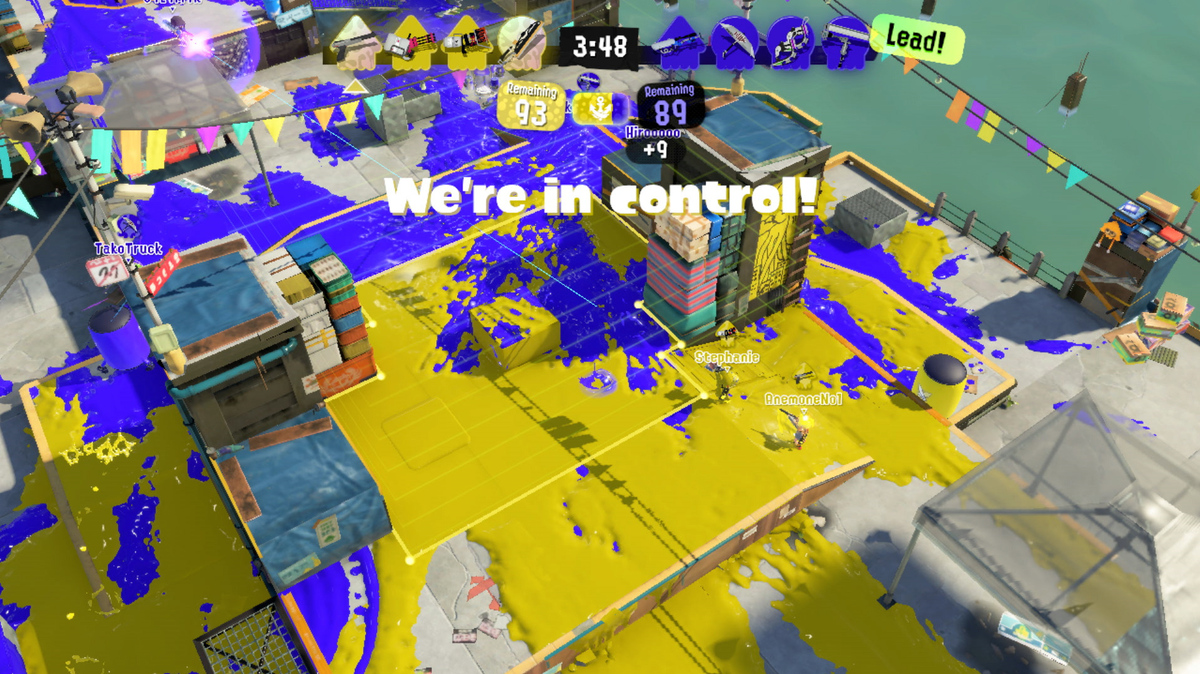Splatoon players readying for ink-splatting mayhem.
Nintendo
hide caption
toggle caption
Nintendo

Splatoon players readying for ink-splatting mayhem.
Nintendo
When Nintendo launched Splatoon in 2015, it catapulted the ink-splatting game into an environment rife with hostile players and graphic violence. Here was another online shooter, but one seemingly meant for children, with a cartoonish look and what amounts to ink-filled water guns instead of assault rifles and rocket launchers. Seven years later, Splatoon 3 continues to draw fans as likely to celebrate their newest in-game fashion as they are a big win, in contrast to hyper-competitive shooters that once defined the genre.
Splatoon tasks players with one goal: spraying their team’s ink color over more of the arena’s ground than the opposing team. They power up with stylish clothes and battle in arenas such as abandoned museums, old warehouses, and high-class hotels, accompanied by the songs of squid, octopus, and manta ray popstars. Unlike Call of Duty, no one dies in Splatoon. There’s no obligation to hurt other players, and the “guns” range from light zappers to paint brushes, bathtubs, and even windshield wiper blades.
To put it simply, Splatoon has attracted a one-of-a-kind, welcoming community because it’s good clean fun, despite all the ink.

One of the Splatoon’s many weapons — a giant roller particularly effective at coating the map.
Nintendo
hide caption
toggle caption
Nintendo

One of the Splatoon’s many weapons — a giant roller particularly effective at coating the map.
Nintendo
Something for everyone
“The atmosphere helps build the fantasy of being a fashionable youth in a big city hanging out with friends,” says the host of the Tokyo Game Life podcast, who goes by Mono. He says the original Splatoon found its niche in Japan with its mechanics and style. “Even if you live in a rural area, you can keep up with trends in the streets of Tokyo through Splatoon.”
The formula has enduring appeal. Splatoon 3 released on September 9 this year and broke sales records in Japan, becoming the fastest-selling game in that country.
The series has a smaller but passionate fan base outside of Japan too. Splatoon streamer ThatSrb2DUDE, who built a substantial following on Twitch and YouTube by streaming matches and posting video guides, says its first trailer in 2014 captivated him.
“There’s no game like Splatoon,” he says. “The movement feels amazing, you have to use your weapon to control the flow of battle, you can paint the floor and wall to regain ammunition – there’s so many unique things Splatoon does as a shooter.” Experienced at other competitive games, he praises Splatoon’s deft combination of simple ideas and deep mechanics.

Games are won based on which team’s ink covers the most territory.
Nintendo
hide caption
toggle caption
Nintendo

Games are won based on which team’s ink covers the most territory.
Nintendo
Writer Madeline Blondeau also picked up the first Splatoon when it launched in 2015, but for different reasons.
“Splatoon came out on the first day of summer classes for me,” she says. “That was a rough summer, but Splatoon spoke to me because it was a persistent multiplayer experience I could sink my teeth into and shut out my living situation. I used to be a big Call of Duty girl, but Splatoon didn’t make me feel as horrible for playing. Its bright art style and inviting world design made me feel welcome.”
Flexible and forgiving gameplay
Matt Storm, host of the “Fun” & Games podcast, still plays for similar reasons. They missed the first Splatoon and, since they couldn’t afford Splatoon 2 when it released in 2017, their friends stealthily added it to their Switch as a birthday surprise. Storm says the whole group ended up playing it for the entire weekend and credits Splatoon’s accessibility for its appeal.

Weapon and wardrobe options deepen the game’s strategy.
Nintendo
hide caption
toggle caption
Nintendo

Weapon and wardrobe options deepen the game’s strategy.
Nintendo
Competitive shooters such as Valorant force players to learn each character’s unique skills and use them perfectly, Storm says. Splatoon offers more flexibility and even rewards players for just having fun.
“You don’t need twitch reflexes to splat other squid kids,” Storm says. “The variety of weapons makes it easier to just focus on coverage on the map. You can be a wildcard and mess with everyone and still pull out the victory.”
Equally important for Storm is Nintendo’s approach to connecting players. Splatoon only lets strangers interact directly with an extra phone app called “SplatNet.” It omits the in-game voice chat so routinely abused in other online games like Call of Duty. Though it makes strategizing in Splatoon more difficult, fans appreciate the extra buffer between them and potentially toxic teammates.
Setting the tone
Thomas Ang, professional pianist with The Royal Ballet, appreciates the casual and competitive facets of the series, but it was the sound design that first caught his ear, prompting him to make Splatoon one of the few games he plays regularly.
Ang particularly appreciates the attention to detail. Shiver, Splatoon 3‘s idol, speaks over a pentatonic melody drawn from Japanese musical traditions, while the intense Salmon Run mode skips beats to create an unsettled tempo that ramps up the tension.

Shiver, one of the headlining idols of ‘Splatoon 3.’
Nintendo
hide caption
toggle caption
Nintendo

Shiver, one of the headlining idols of ‘Splatoon 3.’
Nintendo
Ang says he could tell the composers and musicians who scored Splatoon enjoyed themselves immensely. He believes the exuberance spills over into the game itself and the culture it helps create.
“The charm of this is that they’ve managed to couch these musical performances as an integral part of a world,” he says. “Even though there is cartoon violence, it is never an actual shooter with specific good guys versus bad guys. Your leader is just your idol, and you pick them because you like them.”
A safe space
All the players I spoke with for this piece agreed that this emphasis on self-expression sets Splatoon apart and fosters an open, safe community, particularly for LGBTQIA+ people.
“As a pansexual, nonbinary human, I very much love how Splatoon has become this queer refuge supporting trans rights, [while] calling out racism and homophobia,” Storm says. “It’s not queer because the creators of Splatoon are queer. They might be, but it’s queer because it gives you the freedom to express yourself in a queer way, very easily, whereas a lot of games don’t.”

Some of the diverse character appearances possible in ‘Splatoon 3.’
Nintendo
hide caption
toggle caption
Nintendo
Ang points to the conversation that sprang up after Nintendo introduced Shiver, whose androgynous appearance prompted speculation of whether Shiver is non-binary, as an example of how far Splatoon has come.
Even though Nintendo later confirmed Shiver as female, “the fact that you can even begin to have this conversation in a society like Japan, which is far more far more closeted about stuff like that, is a massive success,” says Ang. “And it’s the aesthetic that made it possible.”
Storm says a vocal minority of Splatoon players have pushed back against this kind of diversity, but says they can’t “break through the noise.” Streamer ThatSrb2DUDE also appreciates that about the game’s fans.
“The Splatoon community is friendly and welcoming, and it’s intentionally welcoming,” he says. “It doesn’t matter who you are. It’s a tight-knit community, and if you join us, we’re going to welcome you in.”
Josh Broadwell is a freelance writer who specializes in video games and entertainment. You can find him on Twitter @FionnTheBrave

Be the first to comment